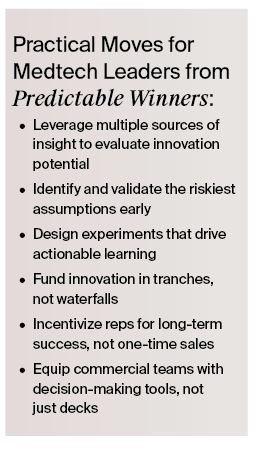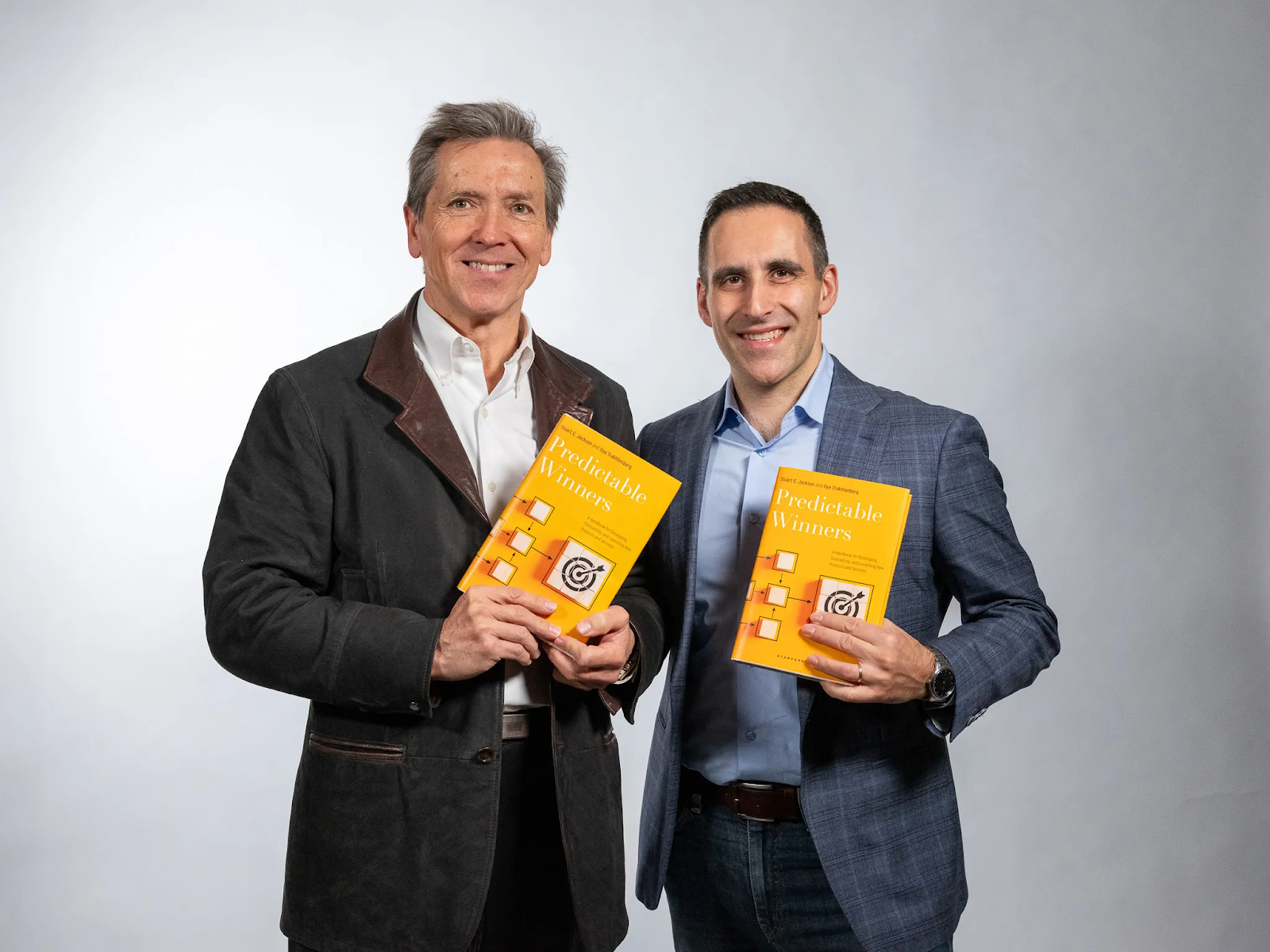
Launching a new medical technology is always a gamble, but according to Ilya Trakhtenberg and Stuart Jackson of L.E.K. Consulting, a systematic, step-by-step approach to innovation can manage risk and unlock the full potential of breakthrough innovation for organizations—far surpassing industry benchmarks.
Most innovations fail. And most companies struggle with innovation. Case in point: Nearly all the growth in the S&P 500 (prior to 2025 YTD) has been driven by just seven companies, the so-called “Magnificent Seven”—Alphabet, Amazon, Apple, Meta, Microsoft, NVIDIA, and Tesla. Between 2013 and 2019, they delivered 19% compound returns. The other 493 companies in the index delivered just 2% in that time period. And medtech is no different: the top five market cap growers accounted for 60% of all of the industry’s market cap growth from 2015 to 2024, and a full 80% of it since 2019. Studies show that of the thousands of product launches across industries each year, 70-90% fail.
So how do you bridge that gap if you’re a medtech company looking to succeed with a novel technology? And not only that, but build an enduring franchise?
According to Ilya Trakhtenberg, a partner at L.E.K. Consulting and co-author of the new book, Predictable Winners: A Handbook for Developing, Forecasting, and Launching New Products and Services, in a recent conversation with The Lens, along with his co-author and Vice Chair of L.E.K. Consulting, Stuart Jackson, success is a learnable, doable process.
But this isn’t a book review. It’s a field guide for founders, operators, and commercial leaders who know that FDA clearance alone won’t get your product into the hands of clinicians, or into the standard of care.
“While there may be certain things that are special about the Magnificent Seven, and other successful entities, the way that they pursue innovation is a little bit different, and it is learnable,” Trakhtenberg told The Lens. “Our mission was to show that success in innovation isn’t about luck, it’s about de-risking at every stage of the journey—from concept through commercialization. Our philosophy is akin to the movie Ratatouille, but instead of anyone can cook, we believe anyone can innovate.”
The key is identifying your organization’s weak spots and closing the gaps.
Drawing from decades of consulting experiences and hundreds of product launches across industries, Trakhtenberg and Jackson’s view is that innovators—be it medtech innovators or those in other industries—need to systematically eliminate the sources of failure from step to step.
“We essentially outline what good looks like at each step, what are the common pitfalls, and how to avoid them,” says Trakhtenberg. “We go through that for the whole journey. Our point is you need to think about it as systematically managing the entire innovation process.”
The authors’ lessons are particularly relevant for the medtech ecosystem, based on the increasingly complex but yet essential nature of life-impacting innovation. For those launching new products and services in this arena—and especially those with novel breakthrough products where the pathway to market is more uncertain and difficult—they emphasize the importance of structured execution, organizational readiness, and strategic commercialization to drive adoption and long-term impact. These qualities can help separate sustained medtech innovation from fleeting success.
Medtech Innovation Journey Framework
To make innovation more predictable, Trakhtenberg and Jackson lay out a five-stage journey for product development, in which each stage helps reduce uncertainty and builds momentum:
-
Configuring for success:
Embracing a systematic approach to managing every step of the innovation journey, with constant reevaluation in light of new information and with the right personal mindset on the part of those leading innovation teams.
-
Developing product and service concepts:
Sourcing and developing high-potential innovation ideas, taking advantage of lean approaches to concept development and assessment, including tactics large organizations can use to embrace breakthrough innovation.
-
Forecasting revenue:
Developing a realistic forecast and business case for an innovation—including understanding opportunity size, target customers, adoption expectations, competitive threats, and optimal pricing and pricing models. If the forecast isn’t robust enough to convince management or investors, or if the necessary product or service concept doesn’t appear to be achievable, then you’re better off walking away at the outset.
-
Ensuring commercial success:
Taking the key steps and overcoming the hurdles involved in going from fully developed concept to successfully launching and generating revenue, including proactively identifying and addressing adoption barriers, creating a launch plan, and preparing the organization for successful launch execution.
-
Creating value for the long-term:
Avoiding the traps that cause many organizations to destroy value after the launch, and using product innovation as part of the broader corporate development agenda for different types of organizations.
Here, Trakhtenberg shares a few takeaways from Predictable Winners for each stage, as food for thought to medtech stakeholders looking to improve their innovation strategy and execute with confidence.
Stage 1: Configuring for Success - A Systematic Approach to Beating the Odds
Between 70 and 90% of new product launches fail. And most companies never figure out why, say Trakhtenberg and Jackson. In medtech, where capital is scarce and clinical complexity is high, the odds can feel even steeper.
“Our industry depends on a pipeline of real, transformative innovation,” says Trakhtenberg. “But the easy wins are gone. What’s left are the tough problems. And there are plenty of unmet needs.”
Tighter capital, complex regulations, and often longer product development timelines mean there’s no room for sloppy execution.
“We can’t afford to guess anymore,” he adds. “We need structure, discipline, and courage.”
Success, says Trakhtenberg, isn’t about getting lucky. It’s about managing risk in a disciplined way. “Our mission is to show that innovation success is learnable. It’s about de-risking at every stage of the journey.”
Medtech companies often depend on acquisitions to stay innovative. But integrating those technologies successfully is the real challenge. The real problem they face lies in generating an attractive return on investment in product and service innovations, say Trakhtenberg and Jackson.
“You can’t throw products out there and hope they stick—especially in medtech.”
“It’s not enough to just buy stuff and hope it works,” Trakhtenberg continues. “With factors such as regulation, science, and market complexities, you can’t throw products out there and hope they stick—especially in medtech.”
The most effective innovators take a long view, thinking across the entire journey—from concept to commercialization and beyond. Trakhtenberg and Jackson describe what “good” looks like at each step and outline how to avoid the most common mistakes.
The result? More disciplined investment decisions, fewer false starts, and a portfolio tilted toward winners, not waste. The goal isn’t perfection. It’s progress—through structure, iteration, and a repeatable process that any medtech company can adopt.
Configuration Tips
In the first few chapters of their book, Trakhtenberg and Jackson recommend that companies manage risks by evaluating multiple indicators for success:
- There is no single ingredient that guarantees success; even the best ideas will fail if other elements of the innovation journey are not executed successfully.
- Leverage multiple sources of evidence such as product analogs, market research, and live trials.
- Be aware of the strengths and prejudices of your own organization. Just because you have a strong market insights group or a world-class rapid prototyping team does not mean that you should ignore other sources of information.
- Take time to experiment, but make sure those experiments translate into actionable insights.
Stage 2: Developing Product and Service Concepts - Embrace a Startup Mindset
Innovation often stagnates in large organizations due to risk aversion and organizational inertia, says Trakhtenberg. They can struggle with the kind of breakthrough medtech innovation that’s more often associated with nimble startup enterprises.
What makes startups special in this regard? They tend to flourish when there is an established ecosystem of talented entrepreneurs and willing backers, say Trakhtenberg and Jackson. This creates a reinforcing cycle for exchanging and refining ideas; attracting, developing, and motivating talent; and recycling financial gains from successful exits into new opportunities.
But what if you’re an established business trying to develop breakthrough innovation?
You can always outsource it, or you can foster an environment within your organization to focus on specific innovations. A key point that Trakhtenberg and Jackson emphasize in Predictable Winners is the importance of instilling a startup mentality within medtech giants.
“One of the biggest challenges is maintaining the magic of a startup inside a larger organization,” says Trakhtenberg. “There are a lot of organizational best practices that large organizations can onboard from startups to try to recreate much of the feel, but in a real and actionable way. You need to create an environment where risk-taking is encouraged, and failure is seen as part of the process.”
Broad recommendations on how to get there:
- Build a dedicated team
- Reward milestone-driven progress, not just headcount
- Create internal venture-style funding mechanisms (both positive and negative)
- Shield breakthrough teams from legacy bureaucracy
- Incentivize learning and experimentation
He points to Intuitive Surgical as a rare example of how to do this well. (Read more about Intuitive Surgical’s journey and CEO Gary Guthart in this issue’s Cover Story.)
Trakhtenberg advises that large medtech firms improve their internal innovation capabilities rather than relying solely on external acquisitions.
The table below, excerpted from Predictable Winners, summarizes the key organizational challenges and potential solutions for early-stage development of breakthrough innovations in large organizations.
Enrich Products Using Digital
Predictable Winners also highlights the necessity of integrating digital capabilities into medtech strategies, not as a separate initiative but as a fundamental part of business operations.
“Talking about digital strategy today is like talking about internet strategy 25 years ago,” says Trakhtenberg. “It’s not a nice-to-have—it’s foundational. Digital is here to stay and you have to be thoughtful about how you’re incorporating it.”
He offers a digital value hierarchy, demonstrating how data becomes exponentially more valuable when used to drive real-time decision-making, as seen in today’s advanced closed-loop insulin delivery systems and, going forward, in AI-assisted robotic surgery:
- Detect: Capture raw data
- Analyze: Spot patterns and anomalies
- Act: Drive automated or guided clinical actions

“The more autonomous your solution, the more value it delivers. Using the example of closed-loop insulin delivery systems, it is also disrupting an industry, in the way patients are empowered to monitor themselves,” he notes.
Stage 3: Forecasting Revenue and Creating a Bulletproof Business Case - Strategic Foresight
A compelling revenue forecast and business case for a new product or service concept are critical to winning support from investors and other stakeholders, say Trakhtenberg and Jackson. What’s more, a rigorous research and forecast development process covering opportunity size, target customers, realistic adoption expectations, competitive threats, and pricing will generate conviction in a revenue forecast and lay the groundwork for a successful commercial launch.
The authors say that one of the most common issues they see in medtech is a false understanding of who the early adopters should be for a company.
“Most medtechs try to sell to their friends and family—advisors, KOLs, longstanding customers, investigators in trials. These are not necessarily the best early adopters—you will inherently run out of friends and family,” says Trakhtenberg. “You need adopters who love your product and are willing to become champions and references. Being pickier with early adopters is often critical to successfully segmenting customers.”
Another common challenge is underestimating the competition. An important part of assessing competitive threats is to think like a competitor, and assume that they are at least as smart as you are.
Many medtech startups, and larger companies, underestimate how quickly and aggressively competitors will react to their innovations. Trakhtenberg stresses the importance of strategic foresight.
“One thing that we recommend executives spend more time on is war gaming, where you roleplay as different competitors,” he says. “It’s a tactic that can be extremely helpful for really putting yourself in the shoes of your competitors to think through, what are they realistically going to do? If you were running that business, what would you do? You end up with a far more nuanced understanding of what to expect and then you can, as an innovator, plan. People don’t actually do that very often, or they’re not thoughtful enough about it.”
Trakhtenberg notes that by proactively considering how rivals will adjust pricing, messaging, and product positioning, innovators can strengthen their market strategy prior to launch.
One last point on competition: don’t forget to look ahead.
“Just because you are the disruptor today doesn’t mean you won’t be the disrupted tomorrow,” says Trakhtenberg. Think one year post-launch, three years, five years, and beyond.
“Just because you are the disruptor today doesn’t mean you won’t be the disrupted tomorrow.”
Stage 4: Ensuring Commercial Success - Where Medtech Often Stumbles
Trakhtenberg and Jackson’s research shows that one of the biggest gaps when it comes to the entire innovation journey is when people start preparing for launch. Poor commercialization—not poor technology—is the most common reason for launch failures.
“The best practice is to understand your adoption barriers, which ones matter the most, and how you can overcome them as much as physically possible before you’re on the market. Once you launch, it’s too late to fix fundamental issues,” says Trakhtenberg.
One of the most overlooked aspects of a successful medtech launch is proactively identifying and mitigating adoption barriers, notes Trakhtenberg. Without thorough preparation, even the most innovative technologies can struggle to gain traction in the market.
“The best innovators don’t just launch a product; they actively track and address adoption hurdles—whether it’s surgeon training, workflow integration, or reimbursement alignment,” he says.
Questions for innovators to ask include understanding how their customers will look at the product, he continues. “How is this going to fit in their workflows? Do they get the economics? Are the incentives aligned for the clinicians, for the administrators, for your reps?”
Trakhtenberg cites Stryker’s Mako and Procept BioRobotics as companies that effectively identified and mitigated obstacles with their innovations, ensuring smoother market entry.

Leakage Analysis: Identifying Market Drop-Off Points
Understanding why potential customers abandon a product at various stages of the buying journey is critical to improving adoption rates, say the authors of Predictable Winners.
“A structured leakage analysis helps companies pinpoint where they’re losing potential or existing customers, and why—whether it’s lack of awareness, misaligned incentives, patient referral issues, workflow challenges, or maybe the footprint in the OR is wrong. We saw that with some of the robotics technologies,” says Trakhtenberg.
“Understanding these barriers and what you can do to address them, then prioritizing which ones are worth your time, effort, and money to go after, is something that I can’t tell medtech clients to do more of,” he continues.
This approach also helps ensure that innovations keep being used, and don’t end up gathering dust in a hospital storage room.
Placement or getting a product on the shelves doesn’t ensure utilization.
Trakhtenberg notes that very few companies do a good enough job of understanding the barriers to adoption and coming up with effective strategies for overcoming those barriers before they’re on the market. “That’s how you end up with surprises like, ‘Well, adoption isn’t going as quickly as we thought,’” he says. “And for a startup, that can be the difference between life and death.”
Stage 5: Creating Value for the Long-Term - Avoiding Traps that Destroy Value
With tougher regulatory hurdles, higher-risk innovation, and funding challenges, Trakhtenberg warns that medtech must build stronger internal capabilities to drive future growth.
Key considerations at this stage of the commercial success journey include paying careful attention to these five key areas: operations, competition, international expansion, resourcing, and managing investor expectations. The authors note that innovators need to understand how hard it is to maintain success and growth beyond the first product, and be prepared to invest accordingly.
From a long-term perspective, incremental developments can be utilized to complement breakthrough innovation, and partnerships and acquisitions are powerful tools for accelerating innovation value.
“Be a garage startup with a Fortune 500 business plan.”
“Focus on finding the best ideas, whether those come from internal teams or potential acquisition targets,” advise the Predictable Winners authors. “Be a garage startup with a Fortune 500 business plan.”
The Big Takeaway
For medtech teams navigating longer timelines, tighter margins, and rising complexity, Predictable Winners offers not just insights—but an actionable blueprint.
“Our goal is to offer time-tested best practices that give innovators some pause, and to think about applying these principles to their own journeys. The key takeaway is that the companies that succeed will be the ones that improve their ability to manage breakthrough medtech innovation—and maximize their odds of success,” says Trakhtenberg.
“Innovation is the lifeblood of this industry, but it’s getting harder,” he continues. “The companies that succeed will be the ones that improve their internal ability to manage breakthrough innovation and maximize their odds of success.”

Ilya Trakhtenberg (on the right in the photo) is a Partner and Managing Director in L.E.K. Consulting’s Chicago office and a leading partner in its healthcare practice. In his more than 15 years with L.E.K., he has led hundreds of engagements with a wide range of corporate and private equity clients to develop and launch innovative new products, accelerate business growth, and deliver superior investment returns. He has published more than a dozen journal articles, serves as a regular speaker at industry conferences, and founded L.E.K.’s MedTech Launch Center of Excellence. Trakhtenberg is also a past recipient of M&A Advisor’s Emerging Leaders Award and a board member of L.E.K.’s global Sustainability Centre of Excellence.
Trakhtenberg studied Economics and Political Science at Northwestern University and was awarded an MBA with Honors from the Kellogg School of Management.
Stuart Jackson (on the left in the photo) is Vice Chair of L.E.K. Consulting, where he advises clients on organizational performance, governance issues, and strategic growth. He previously served as L.E.K.’s Global Managing Partner for nine years and has held key leadership roles, including Americas Region Head and Chicago office head and the firm’s Board of Directors.
Over his career, Jackson has worked with hundreds of clients across industries such as medtech, manufacturing, and consumer products, helping them achieve higher growth, increase profit margins, expand product offerings, and complete over 100 M&A transactions.
Jackson is a past recipient of Consulting Magazine’s Top 25 Consultants award. He is the author of the highly acclaimed book “Where Value Hides: A New Way to Uncover Profitable Growth for Your Business” and dozens of articles published in journals such as the Wall Street Journal, the Journal of Business Strategy, Forbes and Harvard Business Review. Before joining L.E.K., Jackson worked as a manufacturing engineer with BAE Systems. He holds an engineering degree from Cambridge University and earned his MBA with distinction from INSEAD, where he was awarded a NATO Fellowship.
17011 Beach Blvd, Suite 500 Huntington Beach, CA 92647
714-847-3540© 2025 Life Science Intelligence, Inc., All Rights Reserved. | Privacy Policy







